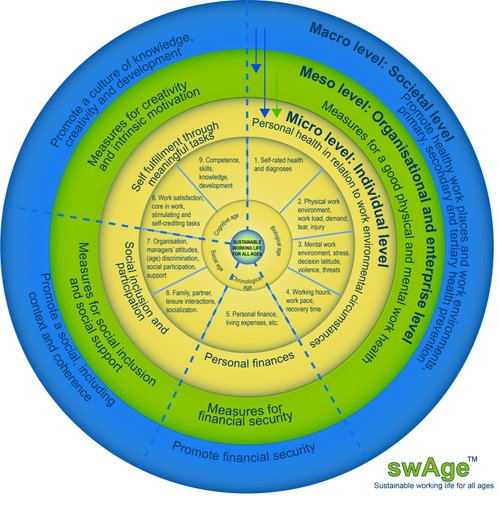Sustainable working life for all – the swAge model from a small business perspective

Human age is easily a sensitive and often overlooked topic of conversation. There are many stereotypes and negative connotations associated with old age. Many young people (under the age of 25) feel older than their chronological age suggests. Older people, on the other hand, like to see themselves younger than their age would suggest. The older we get, the more certain we think we are younger than our chronological age.
Focusing talk about age on the number of years of life makes it difficult to talk about the subject. Kerstin Nilsson, a Swedish professor of public health, has developed a swAge model for coping with working life, which can be used to look at the complex entirety within which people make their decisions to continue working at an older age, for example.
Nilsson talks about functional age, which includes biological, social, and cognitive age. Biological age is affected by genes and lifestyles, but also the workload. Social age means how we are understood at different stages of life. For example, there are different stereotypes associated with age stages that may affect working life. Cognitive age refers to the functioning of the brain and thoughts. This is where multidimensional development takes place in human life: as a child, it is faster and easier to learn completely new things, while when older, life experience and accumulated knowledge help in learning, especially when things can be linked to what has already been learned.
It is going comfortably for most older workers and entrepreneurs. In Sweden, only one in ten people aged 55-74 think they are doing worse in working life than when they were younger. In Finland, too, the retention of people over the age of 50 has clearly improved in recent years. However, as the population continues to age, new ways to prolong careers must be constantly sought, and the swAge model developed by Nilsson can help in this task. The basic idea of the model is that in addition to the individual level, the level of organizations and society is also considered. After all, legislation, and the functioning of health care, for example, are very important for how long everyone can work. The model has been developed specifically for the needs of larger organizations. For small businesses, the involvement of the organizational level in the model raises questions. However, can you get something out of the model from a small business perspective?
Nilsson stresses the importance of considering all aspects of the model properly and does not ignore any of them by quickly stating that the matter is ok or irrelevant. Here you will find the model in graphic form in English.
Biological age:
- Diagnosed diseases as well as one’s own assessment of health
- Physical work environment (e.g., working in hot or cold, exposure to chemicals, etc.)
- Mental work environment (stress and perceived demands, including, for example, mental violence)
- Working hours, pace of work and recovery
Chronological age:
- Personal financial situation
- For example, is there an opportunity to reduce working hours when more time is needed to recover
Social age:
- Social inclusion
- Communality
- Participation
- Support
- Confidence
- Safety
Cognitive age:
- Information
- Skills and competences
- Development
- Job satisfaction
- Relevance of work
- Inspiration for work
From the point of view of a solo entrepreneur, the idea is particularly focused on social and cognitive age. If we want to support the resilience of small entrepreneurs at work, we will be more vigorous in promoting support for solo entrepreneurs, especially in various crisis situations. Support should be organized in a solution-oriented way, so that entrepreneurs themselves play a key role in shaping services. Entrepreneurs cannot do this at the expense of their own business, but a fee should be paid for participating in development work. Entrepreneurial organizations, new entrepreneurship centers and other actors are already doing a lot of good for entrepreneurs. Funding for business support should be long-term and monitoring results is, of course, important. Legislative changes and, for example, various digital solutions must also be predictable and accessible to small businesses.
When it comes to the sector of cognitive age, meaningful and inspiring work assignments are often a strength in the life of a solo entrepreneur. Even if there is a lot of need and enthusiasm, it is often difficult to find time for learning and development. I hope that the service center for lifelong learning and employment set up by the Ministry of Education and Culture will really take on the task of enabling lifelong learning for solo entrepreneurs as well.
In the EntreFox project, we have met enthusiastic, skillful entrepreneurs. It is comforting that enjoying oneself at work, experiencing the meaning of work and having a passion for one’s own work are the most likely predictors of a long-term endurance in working life.
Tytti Steel
PhD, docent, University of Helsinki
Originally posted on the 9th of May, 2022
